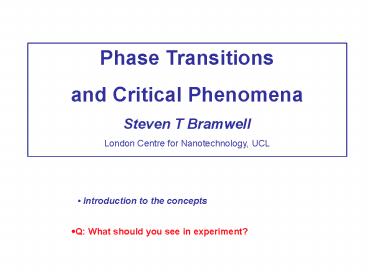Phase Transitions PowerPoint PPT Presentation
1 / 52
Title: Phase Transitions
1
Phase Transitions and Critical Phenomena Steven
T Bramwell London Centre for Nanotechnology, UCL
Introduction to the concepts
- Q What should you see in experiment?
2
Plan of Lecture 1 Phase Transitions
Introduction 1. Ising model 2. Spin and
Lattice Dimensionality 3. Effect of Dipolar
Interactions
3
Microscopic interactions
- Exchange Hex
- Dipole-dipole Hdip
- Single ion HSI
- External Field HZeeman
? Try and capture with simple spin models
4
Frustration versus (lattice) disorder
Frustration a combined effect of lattice and
interaction
spin ice spin liquid
Periodic order
spin glass
percolation
5
Order parameter, correlation function and
susceptibility
6
Intensive versus non-intensive order parameter
7
(1) The Ising Model
8
Ising paramagnet in a field
9
Ising Ferromagnet with long range exchange
interactions
10
1D Ising ferromagnet with short range exchange
interactions
N spins N-1 bonds
Partition Function
11
Correlation function
12
2D Ising ferromagnet with short range exchange
interactions
13
Two Real Ising Magnets
K2CoF4 - nn AFM interactions
14
K2CoF4 HoRh4B4
M C
M
T
T
Hirakawa Ikeda Ott et al.
15
(2) Spin and lattice dimensionality
Nine (D,n) classes
16
Size dependence of Order Parameter at finite T
(Classical ferromagnetic models Mermin-Wagner
Theorem)
17
Phase Transition at finite T (classical
ferromagnetic models)
18
Phase diagram 2D Ising vs 2D-XY
19
(3) Effect of Dipolar Interactions
Dipole interaction D lt 3 convergent (short
ranged, weak) D 3 conditionally convergent
(long ranged)
Note of caution observation of the following
effects depends on the details of the system!
20
Effect of Dipole-dipole interactions in 3D
21
Order parameter M Classical ferromagnetic models
with dipolar interaction at equilibrium
22
Phase diagram 3D Heisenberg vs
3D-Heisenberg-dipolar (soft FM)
23
Conclusions of Lecture 1
- Intensive and non intensive order parameters
- Nine D-n classes various partitions
- But what should we see in experiment??!
24
Plan of Lecture 2 Critical Phenomena
- Introduction
- Intensive Order Parameter
- - critical exponents, RG theory, crossover
- 2. Non-Intensive order parameter
- - 1D models, 2D-XY model
- 3. Conclusions
25
Critical exponents and exponent equalities
- Power law behaviour arises from scale invarience
- Exponents depend on certain symmetries (not on
fine details) - (D,n) Universality classes define sets of
exponents
26
Renormalisation Procedure
27
Renormalisation group flow
28
Crossover
- Exponents associated with linear flow around
fixed points - Thermal properties determined by fluctuations on
scale of x - ? crossover phenomena (small relevant variable)
Interpreting experiment is about assessing the
relevance of variables
29
Ising-like K2CoF4 Phase diagram
30
Fluctuations 2D or 3D ?
- Fluctuations become
- 3D for x2 gt J/J
31
Finite size behaves as a small relevant variable
Apart from very close to TC inter-layer coupling
is equivalent to an effective finite size
32
(2) Non-intensive order parameters
x1/T 1D Heisenberg 1D XY
xexp(1/T) 1D Ising 2D Heisenberg
xexp(1/(T-Tc)1/2) 2D XY
M e-LT
M exp(-elnL-1/T)
M (cN)-T/8?J
33
Magnetization for N108
34
The 2D-XY Model - KTB Transition
VL Berezinzkii, Sov. Phys. JETP 12 480 (1971) JM
Kosterlitz, DJ Thouless, J Phys C 6 1181
(1973) JM Kosterlitz, J Phys C 7 1046 (1974) AP
Young J Phys C 11 L453 (1978)
35
Free Vortex
36
Free vortex energy
37
Free vortex free energy
N places to put the vortex
- Free vortices generated above Tc - destroy local
magnetic order - ? What happens below Tc, ?
38
Vortex Pair Below Tc
Eqiqjln(rij)
? Finite energy local magnetization preserved
39
KTB vortex unbinding transition
Local magnetization Spin waves
Increasing T
40
Low temperature spin wave regime
Keff ? 2/p at Tc/J lt p/2 universal jump
41
Above Tc paramagnetic regime
xexp(b/(T-Tc)1/2 ) cx2-h
42
2D-XY Phase diagram
43
Non Intensive magnetization in critical region
- To account for vortex pairs replace K by
Keff(T,L) in spin wave theory
? Then analyse the behaviour of Keff(T,L)
ST Bramwell and PCW Holdsworth JPCM 5 L53 (1993)
44
Linearised RG equation for Keff
LC Keff? 0
LKeff? 2/p
LCL2
- Stop flow at b L (good approximation for 2D-XY
model, because it is critical even at small
length scales).
Bramwell Holdsworth PRB 49 8811 (1994)
45
Two temperature scales emerge
2/p
TC-TKT4(T-TKT)
? L
46
Calculation of Magnetization
A universal effective exponent!
47
Crossover in quasi-2D XY magnets
48
Crossover to 2DXY behaviour in layered Ising
Antiferromagnet
Rb2MnCl4 Ising D 3?10-3J
Spin flop
H
Van de Kamp et al, Physica B 241-243 570 (1998)
49
Ultrathin films 2.2 ML Fe(100) on W(100)
Elmers et al. J Appl. Phys., 79 4984 (1998)
50
Ni films on Cu(100), Cu(111), W(110)
Huang et al, PRB 49 3962 (1994)
51
Conclusions for Lecture 2
- Universality classes
- Relevent, irrelevant, marginal parameters
- Crossover phenomena
- 2D-XY model - critical phase and effective b
0.23
52
Overall Conclusion
- Q What should you see in experiment?
- A It all depends on the length scale!

